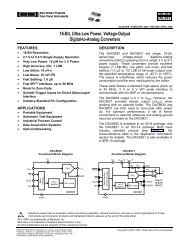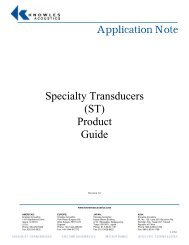AD7714* 3 V/5 V, CMOS, 500 µA Signal Conditioning ADC - dreamm
AD7714* 3 V/5 V, CMOS, 500 µA Signal Conditioning ADC - dreamm
AD7714* 3 V/5 V, CMOS, 500 µA Signal Conditioning ADC - dreamm
Create successful ePaper yourself
Turn your PDF publications into a flip-book with our unique Google optimized e-Paper software.
AD7714<br />
MICROCOMPUTER/MICROPROCESSOR INTERFACING<br />
The AD7714’s flexible serial interface allows for easy interface<br />
to most microcomputers and microprocessors. The flowchart of<br />
Figure 8 outlines the sequence which should be followed when<br />
interfacing a microcontroller or microprocessor to the AD7714.<br />
Figures 9, 10 and 11 show some typical interface circuits.<br />
The serial interface on the AD7714 has the capability of operating<br />
from just three wires and is compatible with SPI interface<br />
protocols. The three-wire operation makes the part ideal for isolated<br />
systems where minimizing the number of interface lines<br />
minimizes the number of opto-isolators required in the system.<br />
The rise and fall times of the digital inputs to the AD7714<br />
(especially the SCLK input) should be no longer than 1 µs.<br />
Most of the registers on the AD7714 are 8-bit registers which<br />
facilitates easy interfacing to the 8-bit serial ports of microcontrollers.<br />
Some of the registers on the part are up to 24 bits, but<br />
data transfers to these 24-bit registers can consist of a full 24-bit<br />
transfer or three 8-bit transfers to the serial port of the microcontroller.<br />
DSP processors and microprocessors generally transfer<br />
16 bits of data in a serial data operation. Some of these<br />
processors, such as the ADSP-2105, have the facility to program<br />
the amount of cycles in a serial transfer. This allows the user to<br />
tailor the number of bits in any transfer to match the register<br />
length of the required register in the AD7714.<br />
Even though some of the registers on the AD7714 are only eight<br />
bits in length, communicating with two of these registers in successive<br />
write operations can be handled as a single 16-bit data<br />
transfer if required. For example, if the Mode Register is to be<br />
updated, the processor must first write to the Communications<br />
Register (saying that the next operation is a write to the Mode<br />
Register) and then write eight bits to the Mode Register. This<br />
can all be done in a single 16-bit transfer if required because<br />
once the eight serial clocks of the write operation to the Communications<br />
Register have been completed the part immediately<br />
sets itself up for a write operation to the Mode Register.<br />
AD7714 to 68HC11 Interface<br />
Figure 9 shows an interface between the AD7714 and the<br />
68HC11 microcontroller. The diagram shows the minimum<br />
(three-wire) interface with CS on the AD7714 hard-wired low.<br />
In this scheme, the DRDY bit of the Communications Register<br />
is monitored to determine when the Data Register is updated.<br />
An alternative scheme, which increases the number of interface<br />
lines to four, is to monitor the DRDY output line from the<br />
AD7714. The monitoring of the DRDY line can be done in two<br />
ways. First, DRDY can be connected to one of the 68HC11’s<br />
port bits (such as PC0) which is configured as an input. This<br />
port bit is then polled to determine the status of DRDY. The<br />
second scheme is to use an interrupt driven system in which<br />
case, the DRDY output is connected to the IRQ input of the<br />
68HC11. For interfaces which require control of the CS input<br />
on the AD7714, one of the port bits of the 68HC11 (such as<br />
PC1), which is configured as an output, can be used to drive the<br />
CS input.<br />
The 68HC11 is configured in the master mode with its CPOL<br />
bit set to a logic zero and its CPHA bit set to a logic one. When<br />
the 68HC11 is configured like this, its SCLK line idles low between<br />
data transfers. Therefore, the POL input of the AD7714<br />
should be hard-wired low. For systems where it is preferable<br />
that the SCLK idle high, the CPOL bit of the 68HC11 should<br />
be set to a logic 1 and the POL input of the AD7714 should be<br />
hard-wired to a logic high.<br />
REV. B –29–<br />
68HC11<br />
8XC51<br />
SS<br />
SCK<br />
MISO<br />
MOSI<br />
P3.0<br />
P3.1<br />
DV DD<br />
DV DD<br />
Figure 9. AD7714 to 68HC11 Interface<br />
The AD7714 is not capable of full duplex operation. If the<br />
AD7714 is configured for a write operation, no data appears on<br />
the DATA OUT lines even when the SCLK input is active.<br />
Similarly, if the AD7714 is configured for a read operation, data<br />
presented to the part on the DATA IN line is ignored even<br />
when SCLK is active.<br />
DV DD<br />
SYNC<br />
RESET<br />
SCLK<br />
DATA OUT<br />
DATA IN<br />
SYNC<br />
RESET<br />
DATA OUT<br />
AD7714<br />
Figure 10. AD7714 to 8051 Interface<br />
Coding for an interface between the 68HC11 and the AD7714<br />
is given in Table XV. In this example, the DRDY output line of<br />
the AD7714 is connected to the PC0 port bit of the 68HC11<br />
and is polled to determine its status.<br />
AD7714 to 8051 Interface<br />
An interface circuit between the AD7714 and the 8XC51<br />
microcontroller is shown in Figure 10. The diagram shows the<br />
minimum number of interface connections with CS on the<br />
AD7714 hard-wired low. In the case of the 8XC51 interface the<br />
minimum number of interconnects is just two. In this scheme,<br />
the DRDY bit of the Communications Register is monitored to<br />
determine when the Data Register is updated. The alternative<br />
scheme, which increases the number of interface lines to three,<br />
is to monitor the DRDY output line from the AD7714. The<br />
monitoring of the DRDY line can be done in two ways. First,<br />
DRDY can be connected to one of the 8XC51’s port bits (such<br />
POL<br />
CS<br />
POL<br />
DATA IN<br />
SCLK<br />
CS<br />
AD7714<br />
2















